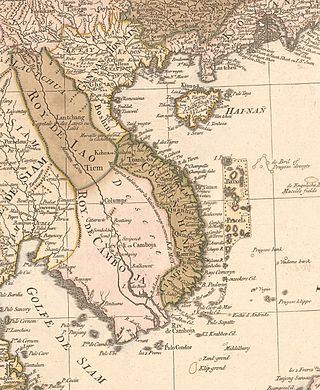Articles related to Vietnam and Vietnamese culture include:

Kiều Chinh is a Vietnamese-American actress, producer, humanitarian, lecturer and philanthropist.

Ninh Bình is a province of Vietnam in the Red River Delta region of the northern part of the country. The province is famous for a high density of natural and cultural attractions, including reserved parks in Cúc Phương National Park and Vân Long, grotto caves and rivers in Tràng An, Tam Cốc-Bích Động and Múa Caves, historic monuments in the Hoa Lư ancient capital, Vietnam's largest buddhist worshiping complex, and the Phát Diệm Cathedral with "eclectic architectural style". Thanks to its adjacency to Hanoi, day trips from the capital are easily manageable.

Hải Dương is a city in Vietnam. It is the capital of Hải Dương, an industrialized province in the Hanoi Capital Region and the Red River Delta in Northern Vietnam. The city is at the midpoint between the capital Hanoi and the major port Haiphong, and is part of the Northern Key Economic Zone. In 2019, Hai Duong city had a population of 507,469.

Gia Lâm is the easternmost urban district (quận) of Hanoi, the capital city of Vietnam. Prior to 2003, the district covered the entire area of Long Biên district, which included Long Biên Bridge, Gia Lâm Airport, Gia Lâm railway station, Gia Lâm bus station and the headquarters of Vietnam Airlines. On 22 September 2023, the Hanoi People Committee approved Gia Lam to become the next urban district of Hanoi.

Emperor Quang Trung or Nguyễn Huệ, also known as Nguyễn Quang Bình, was the second emperor of the Tây Sơn dynasty, reigning from 1788 until 1792. He was also one of the most successful military commanders in Vietnam's history. Nguyễn Huệ and his brothers, Nguyễn Nhạc and Nguyễn Lữ, together known as the Tây Sơn brothers, were the leaders of the Tây Sơn rebellion. As rebels, they conquered Vietnam, overthrowing the imperial Later Lê dynasty and the two rival feudal houses of the Nguyễn in the south and the Trịnh in the north.
The Trần Cao rebellion in 1516 is a rebellion in 16th century Vietnam, led by Trần Cao against the Lê dynasty and is regarded as an important factor leading to the collapse of the Early period Lê. It was the second rebellion led against the Lê, following an uprising led by Trần Tuân in 1511.

Hiệp Hòa is one of nine rural districts of Bắc Giang province in the Northeast region of Vietnam. As of 2019 the district had a population of 237,900. The district covers an area of 201 km2. The district capital lies at Thắng. This is the home country of Trạng nguyên Đoàn Xuân Lôi of the Trần dynasty, Tiến sĩ Trịnh Ngô Dụng of the Lê dynasty, and Đình nguyên Nguyễn Đình Tuân of the Nguyễn dynasty.

Hoàng Mai is an urban district (quận) of Hanoi, the capital city of Vietnam. The district currently has 14 wards, covering a total area of 40.32 square kilometers. As of 2019, there were 506,347 people residing in the district, the highest of all districts in Hanoi. The district borders Thanh Trì District, Thanh Xuân District, Gia Lâm District, Long Biên District, Hai Bà Trưng District.

Long Biên is an urban district of Hanoi, the capital of Vietnam. The district currently has 14 wards, covering a total area of 59.82 square kilometers. As of 2019, there were 322,549 people residing in the district, the population density is 5,400 inhabitants per square kilometer.

Paris By Night 91: Huế, Sài Gòn, Hà Nội is a Paris By Night program produced by Thúy Nga that was filmed at the Terrace Theater at the Long Beach Convention and Entertainment Center on January 12, 2008 and January 13, 2008.

The Imperial Citadel of Thăng Long is a complex of historic buildings associated with the history of Vietnam located in the centre of Hanoi, Vietnam. Its construction began in 1010 and was completed in early 1011 under the reign of Emperor Lý Thái Tổ of the Lý dynasty.

Ỷ Lan or Empress MotherLinh Nhân was a Vietnamese concubine and regent who effectively controlled the imperial government of Vietnam for over 40 years.

Paris by Night 98: Fly With Us to Las Vegas is a Paris by Night program produced by Thúy Nga that was filmed at the Theatre for the Performing Arts in Planet Hollywood Resort & Casino on September 18 and 19, 2009 and had a DVD release on December 10, 2009. The show was hosted by Nguyễn Ngọc Ngạn and Nguyễn Cao Kỳ Duyên.

Paris By Night 99 – Tôi Là Người Việt Nam is a Paris By Night program produced by Thúy Nga Productions that was filmed at Knott's Berry Farm on 16 and 17 January 2010 and released DVD from 9 April 2010. The show was hosted by Nguyễn Ngọc Ngạn, Nguyễn Cao Kỳ Duyên and Trịnh Hội.

The Hanoi Metro is a rapid transit system in Hanoi, the capital city of Vietnam. Owned by Vietnam Railways and operated by Hanoi Metro Company (HMC), it is the first operational rapid transit system in Vietnam. The first line opened to service on 6 November 2021.

The House of Nguyễn Phúc, also known as the House of Nguyễn Phước, was a ruling family of Vietnam. It ruled from the city of Huế in central Vietnam beginning in 1636. As the Nguyễn lords, they often fought with the Trịnh lords, who were based in Hanoi. They were overthrown by the Tây Sơn dynasty in 1776.

The Revival Lê dynasty, also called the Later Lê Restoration in historiography, officially Great Việt, was a Vietnamese dynasty that existed between 1533 and 1789. The Primal Lê dynasty (1428-1527) and the Revival Lê dynasty (1533-1789) collectively formed the Later Lê dynasty.

Nguyễn Xí, or Lê Xí, was a general, politician, and public servant who served as a minister for four generations of rulers during the late Lê dynasty.

The government of the Nguyễn dynasty, officially the Southern dynasty and commonly referred to as the Huế Court, centred around the emperor as the absolute monarch, surrounded by various imperial agencies and ministries which stayed under the emperor's presidency. Following the signing of the Patenôtre Treaty the French took over a lot of control and while the government of the Nguyễn dynasty still nominally ruled the French protectorates of Annam and Tonkin, in reality the French maintained control over these territories and the Nguyễn government became subsidiary to the administration of French Indochina. During World War II the Japanese launched a coup d'état outsting the French and establishing the Empire of Vietnam which was ruled by the Nguyễn government. During the August Revolution the Nguyễn government was abolished in the aftermath of World War II.

















